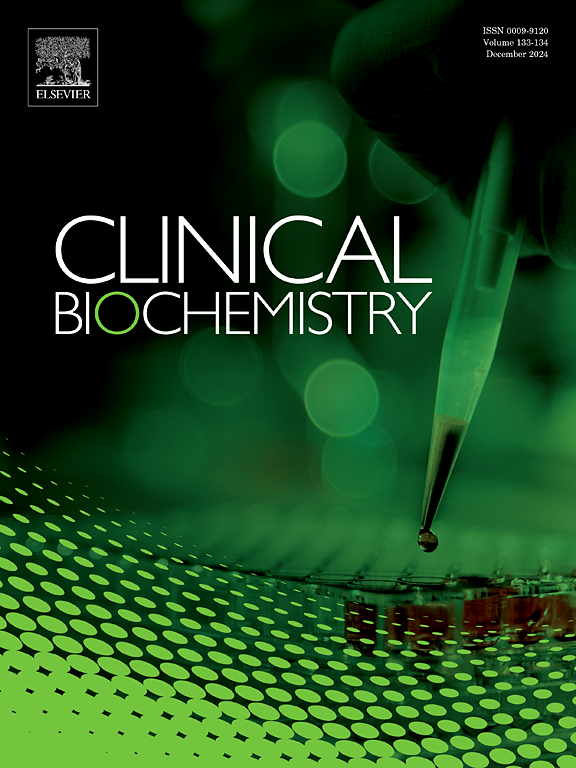Optimizing the indeterminate zone for the DiaSorin LIAISON H. Pylori stool antigen test
IF 2.1
3区 医学
Q2 MEDICAL LABORATORY TECHNOLOGY
引用次数: 0
Abstract
Introduction
Helicobacter pylori (H. pylori) colonization increases the risk of upper gastrointestinal disorders and can be detected by various tests, including the stool antigen test (HpSAT). DiaSorin recommends an HpSAT equivocal/indeterminate zone of 0.90-<1.10, but high variability observed in our laboratory prompted clinical implementation of a broader zone (0.60-<1.80). This study aimed to define an optimal HpSAT indeterminate zone using molecular as reference and urea breath test (UBT) for confirmation.
Materials and Methods
HpSAT and stool molecular results were available from 379 patients, of which 52 had follow-up UBTs. HpSAT was analyzed by the LIAISON HpSAT assay (DiaSorin), UBT by isotope ratio mass spectrometry, and molecular testing by qPCR targeting H. pylori DNA. Logistic regression modeled HpSAT index values against PCR positivity to define an optimal indeterminate zone, supported by clinical performance and flagging rates analyses.
Results
Logistic regression determined an HpSAT index of 0.79 (95 % CI: 0.34–1.14) had 90 % probability of a negative PCR result, and 4.99 (4.09–6.63) had 90 % probability of a positive result, rounded to an indeterminate zone of 0.80-<5.00. Lower thresholds assessed all had ≤ 2 % false negatives, while upper thresholds exhibited decreased false positive rates (22 % to 6 %) as thresholds increased (1.10 to 5.00), with minimal improvement beyond 3.00 (9 %). A modified zone of 0.80–<3.00 offered high accuracy with 12.9 % indeterminate results (DiaSorin’s threshold: 2.8 %; laboratory’s current threshold: 13.1 %).
Conclusions
Our findings show that DiaSorin’s HpSAT indeterminate zone is too narrow to reliably distinguish true positive and negative results in clinical practice. A modified broader zone (0.80–<3.00), derived via logistic regression using PCR as reference, improves diagnostic accuracy while minimizing indeterminate results.
幽门螺杆菌粪便抗原检测的不确定区优化。
导读:幽门螺杆菌(h.p ylori)定植增加上消化道疾病的风险,可通过各种测试检测,包括粪便抗原测试(HpSAT)。DiaSorin推荐的HpSAT模棱两可/不确定区域为0.90。材料和方法:379例患者的HpSAT和粪便分子结果可获得,其中52例随访了ubt。HpSAT采用LIAISON HpSAT法(DiaSorin)分析,UBT采用同位素比质谱法分析,qPCR检测H. pylori DNA。在临床表现和标记率分析的支持下,Logistic回归模型对PCR阳性的HpSAT指数值进行了建模,以定义一个最佳的不确定区域。结果:Logistic回归表明,0.79(95 % CI: 0.34-1.14)的HpSAT指数有90 %的概率为PCR阴性结果,4.99(4.09-6.63)有90 %的概率为PCR阳性结果,四合到0.80的不确定区域。结论:我们的研究结果表明,在临床实践中,DiaSorin的HpSAT不确定区域太窄,无法可靠地区分真阳性和阴性结果。修改后的更宽区域(0.80-)
本文章由计算机程序翻译,如有差异,请以英文原文为准。
求助全文
约1分钟内获得全文
求助全文
来源期刊

Clinical biochemistry
医学-医学实验技术
CiteScore
5.10
自引率
0.00%
发文量
151
审稿时长
25 days
期刊介绍:
Clinical Biochemistry publishes articles relating to clinical chemistry, molecular biology and genetics, therapeutic drug monitoring and toxicology, laboratory immunology and laboratory medicine in general, with the focus on analytical and clinical investigation of laboratory tests in humans used for diagnosis, prognosis, treatment and therapy, and monitoring of disease.
 求助内容:
求助内容: 应助结果提醒方式:
应助结果提醒方式:


